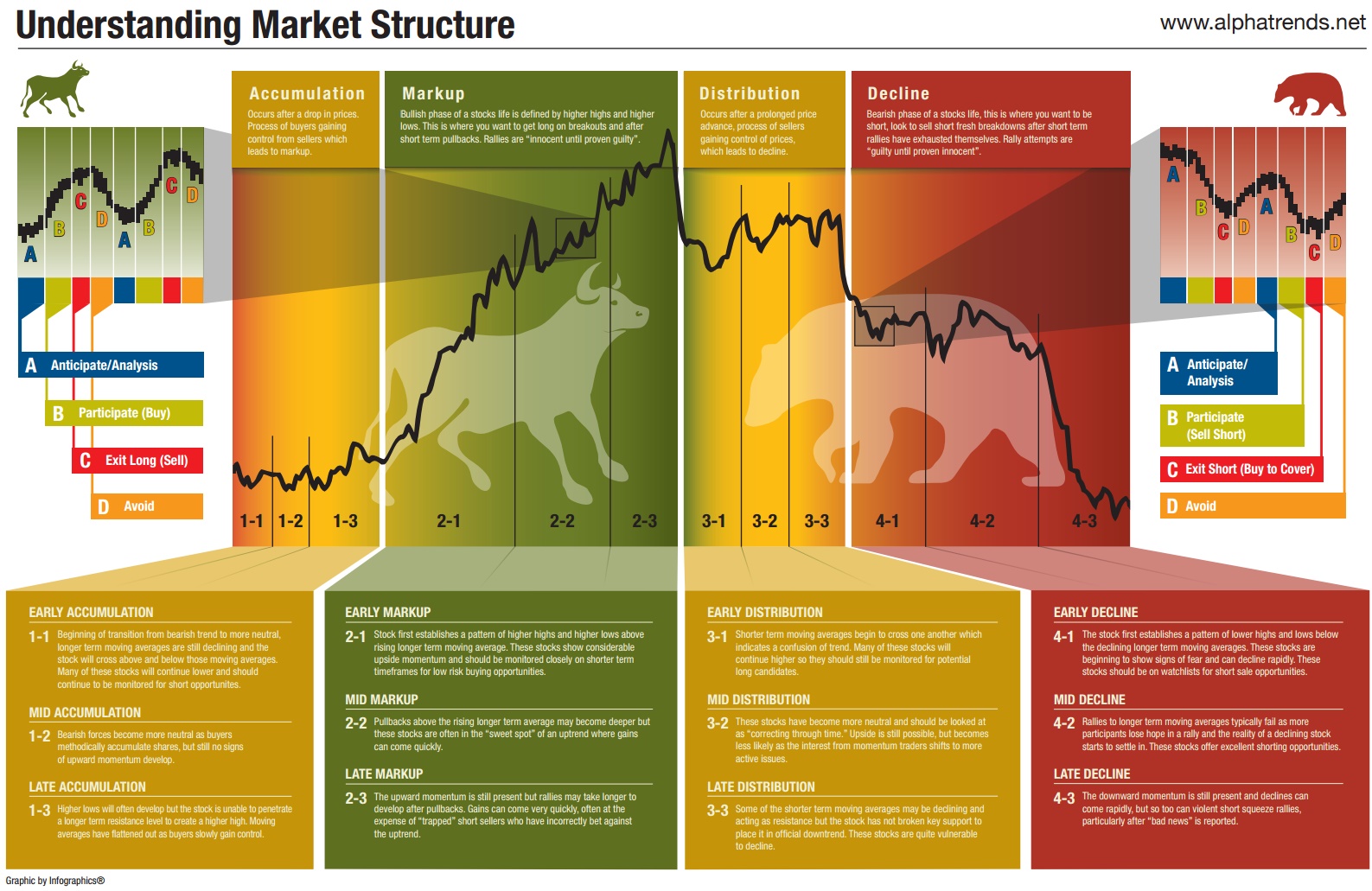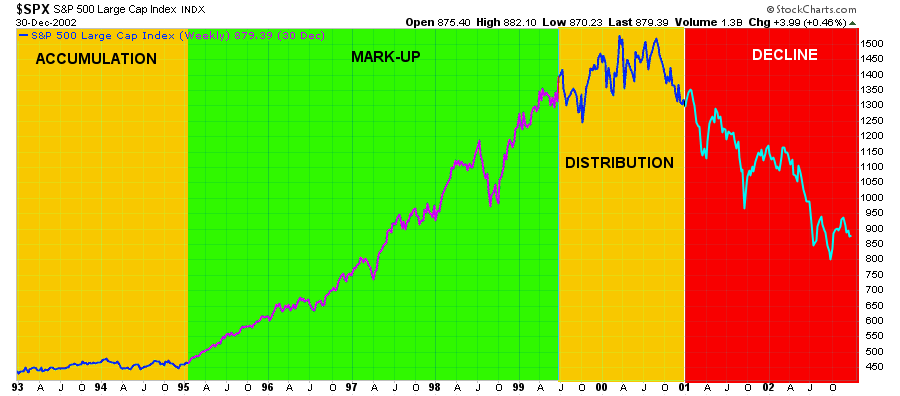Market Cycles And Expected Outcomes
The “Visual Capitalist” website had a terrific market diagram explain the “best time to buy stocks.”
Is it possible to time the market cycle to capture big gains?
Like many controversial topics in investing, there is no real professional consensus on market timing. Academics claim that it’s not possible, while traders and chartists swear by the idea.
The following infographic explains the four important phases of market trends, based on the methodology of the famous stock market authority Richard Wyckoff.
The theory is: the better an investor can identify these phases of the market cycle, the more profits can be made on the ride upwards of a buying opportunity.
So, the question is, 'Where are we now?'
I’m glad you asked.
Let’s take a look at the past two full market cycles, using Wyckoff’s methodology, as compared to the current post-financial-crisis half-cycle. While actual market cycles will not exactly replicate the chart above, you can clearly see the Wyckoff’s theory in action.
S&P 500
1992-2003
The accumulation phase, following the 1991 recessionary environment was evident as it preceded the “internet trading boom” and rise of the dot-com bubble from 1995-1999.
The distribution phase became evident in early 2000 as stocks began to struggle as Enron and WorldCom because poster children for “greed and excess” of the preceding bull market frenzy. It is worth remembering that during this phase the media and Wall Street were touting the continuation of the bull market indefinitely into the future. (Jim Cramer published his list of 10 Tech Companies for the next decade.)
Then, the decline.
2003-2009
Following the dot-com crash, investors had all learned their lessons about the value of managing risk in portfolios, not chasing returns and focusing on capital preservation as the core for long-term investing.
Okay. Not really.
It took about 27 minutes for investors to completely forget about the previous pain of the bear market and jump headlong back into the creation of the next bubble leading to the financial crisis.
Once again, during the distribution phase of the market, analysts, media, Wall Street and now a rise of bloggers, all touted “this time was different,” “green shoots”, “Goldilocks economy” and “no recession in sight”.
They were disastrously wrong.
2009-Present
More than 7 years into the current economic recovery the headlines ring of “no recession in sight”, “the bull market is still cheap” and “this time is different because of Central Banking”.
Need I say more.
Bounces Do Not Imply Ends
There has been a good bit of discussion as of late about the bounce in manufacturing data over the last couple of months as a sign that the “manufacturing recession was now at an end.” To wit:
The U.S. manufacturing sector just batted five-for-five in its version of spring training.
Since mid-2014, the collapse in oil prices has hit manufacturers tied to the energy industry while the rise of the U.S. dollar was broadly crimping activity. These headwinds are no longer strong enough to dim Goldman Sachs Group Inc's (NYSE:GS) “near-term optimism” on U.S. manufacturing.
This is an extremely short-sighted and ill thought-out view.
First, the manufacturing reports are “seasonally adjusted”. These seasonal adjustments are designed to smooth the data over time to account for DECLINES in manufacturing activity during seasonally cold times of they year when inclement weather normally shutters in manufacturing activity.
However, given that the economy just experienced one of the most unseasonably WARM winters in 122 years, activity ran ahead of normal seasonal tendencies. When combined with the normal seasonal adjustments manufacturing data saw extremely sharp and abnormal increases.
This is clearly seen in the chart below -- a composite economic output indicator -- which is comprised of the Fed Regional Manufacturing Surveys, Chicago Fed National Activity Index, Chicago PMI, ISM surveys, NFIB Survey and the Leading Economic Indicators.
Secondly, these bounces are simply normal restocking cycles as inventories are drawn down during protracted declines in activity. Furthermore, as with all economic data, nothing travels in a straight line, either up or down.
However, in particular, the recent bounce in manufacturing data was a clear anomaly caused by the extremely warm winter weather. This could be seen in the recent slate of data points from the Fed Philadelphia Region as shown below:
- February: -2.8
- March: 12.4
- April: -1.6
The weakness in the manufacturing data will likely reassert itself as the seasonal cycle realigns with the seasonal adjustments.
However, if we compare the Economic Output Cycle Index (EOCI) above to both GDP and the Leading Economic Indicator Index, we see a clearer picture of what is currently happening in the economy.
Not surprisingly, the EOCI has bottomed coincident with central-bank interventions, which drag forward future consumption. Unfortunately, when you “drag forward” future consumption today, you leave a “void” in the future that must be filled.
That future “void” continues to expand each time activity is dragged forward until, inevitably, it cannot be filled. This is currently being witnessed in the overall data trends, which are being reflected in the deterioration in corporate earnings and revenues.
While the media continues to “protest too much”, the reality is that earnings and revenue are a direct reflection of real economic activity.
The only question is whether Central Banks can continue to support asset prices long enough for the economic cycle to catch up.
Historically, such a feat has never been accomplished.
Pop-Quiz: Why Did The Market Hit 2100?
Zack’s Research recently published an interesting note discussing the recent market push to 2100.
On Tuesday stocks did make their big push up to 2100. Why did that happen?
A) Because Housing Starts and New Permits came in nearly 10% under estimates.
B) Because Redbook Retail Sales report came in at the lowest level in over two years.
C) Because…just because.
Put me down for C. Once we cleared the 200-day moving average then investors were drawn to 2100 like a moth to the flame. The better question is what happens now?
Indeed, there could be a rush to test the old highs at 2135. But I believe investors have to ask themselves if we truly have the right fuel for that journey to new heights. Recent GDP estimates for Q1 are near 0% growth and earnings outlooks continued to be trimmed.
My sense is that we are close to the end of this rally that started in mid February. Whether that means sideways awaiting new catalysts or heading back south for a while is the greater mystery. However, I would not bank on greater upside coming at this juncture.
I agree with that sentiment exactly.
'But Lance – you just increased exposure at 2080?'
Yes, I absolutely did. I added a very small amount of exposure back into portfolios that have been primarily cash and fixed income since last May when the market turmoil began.
Again, even with this increase, I am still holding a significant weight in cash, to hedge my risk, until further confirmations of a resumption of a rather old “bull market” are visible. Such would entail a breakout to all-time highs and a subsequent pullback that reduces the overbought condition without reversing the underlying “buy signals.”
Such a feat will likely not be easily accomplished, and I highly suspect that I will be “stopped out” of recent additions first.
But for now, the technical indicators, and my discipline, require me to have increased exposure to the market. However, as I was quoted by MarketWatch earlier this week:
Roberts acknowledged that his strategy could be characterized as chasing returns, but said his position is more conservative than average, with 50% allocated to cash.
'We are in the final stages of a bull market—the melt-up stage. Until then, I will remain half-bullish,' Roberts said.
Just some things to think about.






